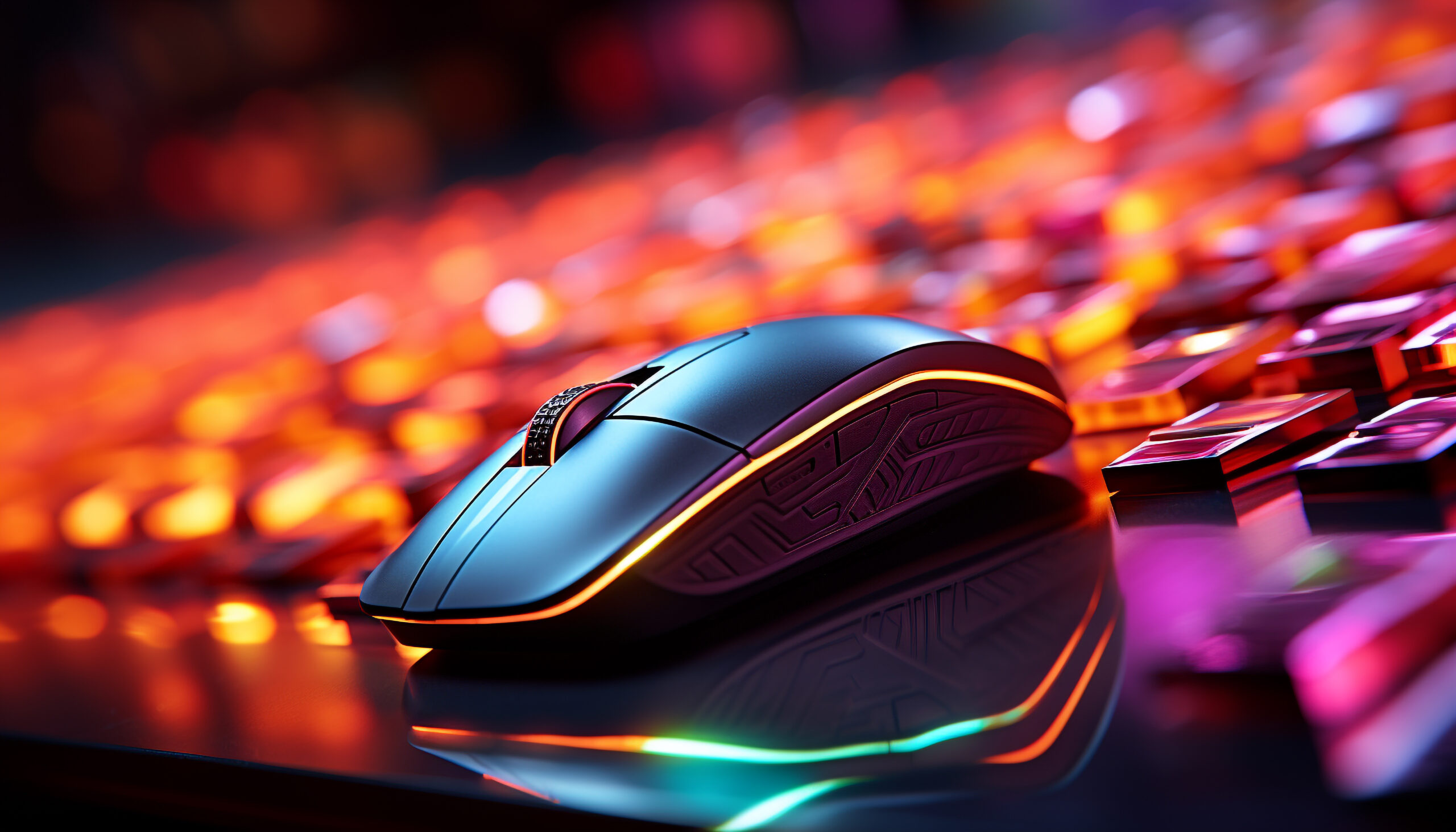Precision and comfort are paramount for graphic design. Choosing the right mouse can significantly impact your workflow and creativity. In this comprehensive guide, we’ll explore the top computer mouse tailored specifically for graphic design professionals. From wired to wireless options, and ergonomic designs to customizable features, we’ll help you find the perfect mouse to elevate your graphic design endeavors.
Product at Glance
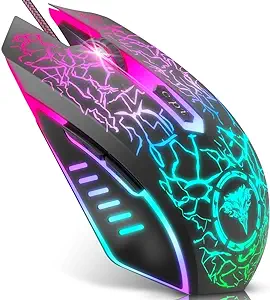 | BENGOO Wired Mouse | Check Price |
 | UHURU Wireless Mouse | Check Price |
 | ProtoArc Wireless Trackball Mouse | Check Price |
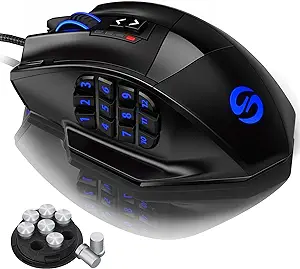 | UtechSmart Venus Mouse | Check Price |
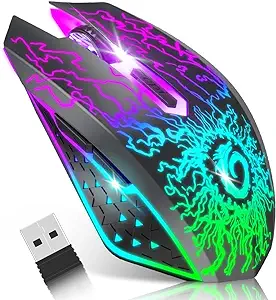 | VersionTECH. Wireless Mouse | Check Price |
|
| Uciefy Q85 Rechargeable Wireless Mouse | Check Price |
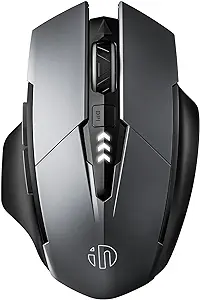 | INPHIC Bluetooth Wireless Mouse | Check Price |
7 Best Computer Mouse for Graphic Design
From precision tracking to ergonomic designs, the article explores the top options that can elevate your graphic design endeavors to new heights. Whether you’re a seasoned professional or an aspiring designer, finding the right wired or wireless mouse is crucial for optimizing your workflow and achieving stunning results. Let’s dive in and discover the best computer mice for graphic design.
1. BENGOO Wired Mouse
 | BENGOO Wired Mouse | Check Price |
Experience reliable performance without breaking the bank with the BENGOO Wired Mouse. Featuring adjustable DPI settings and responsive buttons, this mouse delivers precision and control for intricate design work. Its ergonomic design ensures comfort during extended use, while the wired connection provides stable performance without worrying about battery life. Affordable and functional, the BENGOO Wired Mouse is a solid choice for graphic designers on a budget.
Pros
| Cons
|
2. UHURU Wireless Mouse
 | UHURU Wireless Mouse | Check Price |
Embrace wireless freedom with the UHURU Wireless Mouse, offering smooth tracking and customizable buttons for versatility. Perfect for graphic designers who value flexibility, this mouse combines responsive performance with ergonomic design for comfortable use. While its battery life may be shorter than wired alternatives, the convenience of wireless connectivity makes it a popular choice for those on the go.
Pros
| Cons
|
3. ProtoArc Wireless Trackball Mouse
 | ProtoArc Wireless Trackball Mouse | Check Price |
Revolutionize your design workflow with the ProtoArc Wireless Trackball Mouse, featuring a unique trackball design for precise cursor control. Its ergonomic shape reduces strain on the wrist and arm, making it ideal for long hours of design work. With wireless connectivity and long-lasting battery life, this mouse offers both comfort and convenience. While its unconventional design may take some getting used to, its ergonomic benefits make it a worthwhile investment for graphic designers seeking comfort and precision.
Pros
| Cons
|
4. UtechSmart Venus Mouse
 | UtechSmart Venus Mouse | Check Price |
Elevate your graphic design experience with the UtechSmart Venus Mouse, offering unparalleled customization and precision. This mouse boasts customizable buttons and adjustable weights, allowing users to tailor their setup for optimal performance. With a high DPI sensor and ergonomic design, it’s suitable for both intricate design tasks and extended use. While its larger size may not be suitable for users with smaller hands, its customizable features make it a versatile tool for graphic designers seeking superior control and comfort.
Pros
| Cons
|
5. VersionTECH. Wireless Mouse
 | Version TECH | Check Price |
Experience affordability and convenience with VersionTECH. Wireless Mouse, offering wireless connectivity and ergonomic design. Ideal for graphic designers on a budget, this mouse provides smooth tracking and silent clicking for comfortable use. While some users may encounter connectivity issues, its plug-and-play functionality and ergonomic design make it a practical choice for everyday design tasks.
Pros
| Cons
|
6. Uciefy Q85 Rechargeable Wireless Mouse
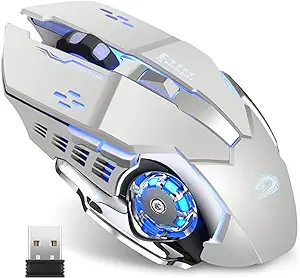 | Uciefy Q85 Rechargeable Wireless | Check Price |
Enjoy the convenience of wireless connectivity and rechargeable battery with the Uciefy Q85 Rechargeable Wireless Mouse. Its compact design and silent clicking feature make it perfect for on-the-go graphic designers. While its smaller size may not be suitable for users with larger hands, its rechargeable battery and wireless convenience offer flexibility and mobility for design work anytime, anywhere.
Pros
| Cons
|
7. INPHIC Bluetooth Wireless Mouse
 | INPHIC Bluetooth | Check Price |
With Bluetooth connectivity and a sleek, minimalist design, the INPHIC Bluetooth Wireless Mouse is perfect for graphic designers who prioritize aesthetics. Its silent clicking feature and long battery life enhance the user experience. However, its lack of customizable buttons may be a drawback for some users.
Pros
| Cons
|
Our Best Pick Computer Mice for Graphic Design
 | UtechSmart Venus | Check Price |
After careful consideration, we’ve identified the UtechSmart Venus Mouse as our top pick for graphic design. This mouse offers a perfect blend of customizable features, precision tracking, and ergonomic design, making it a standout choice for graphic designers.
One of the key features of the UtechSmart Venus Mouse is its extensive customization options. With customizable buttons and adjustable weights, users can tailor the mouse to their unique preferences and workflow. This level of customization allows for seamless integration into various design tasks, from intricate detailing to rapid navigation between tools.
In addition to its customizable features, the UtechSmart Venus Mouse boasts a high DPI sensor, ensuring precise tracking for even the most intricate design work. Whether you’re working on detailed illustrations or editing high-resolution images, this mouse delivers the accuracy and responsiveness needed to bring your creative vision to life.
Moreover, the ergonomic design of the UtechSmart Venus Mouse prioritizes comfort during prolonged use. Its contoured shape and rubberized grips provide a comfortable and secure hold, reducing strain on the hand and wrist during extended design sessions. This ergonomic design ensures that users can maintain focus and productivity without discomfort or fatigue.
Overall, the UtechSmart Venus Mouse combined with mouse pad with wrist support stands out as the ideal companion for graphic designers seeking a reliable, customizable, and ergonomic mouse. With its extensive features and exceptional performance, it’s no wonder why this mouse earns our top spot as the best pick for graphic design.
How do We Pick the Best Computer Mice for Graphic Design
Selecting the best computer mice for graphic design involves considering several crucial factors to ensure optimal performance and user satisfaction. Below, we’ll delve into the key criteria we used to evaluate and pick the top contenders for graphic design tasks.
1. Precision and Tracking
Graphic design often requires precise cursor control and accurate tracking to manipulate elements with finesse. Therefore, we prioritize mice with high-quality sensors and adjustable DPI settings. These features allow users to customize sensitivity levels to match their preferences and the demands of their design projects.
2. Customization Options
Customizability is essential for tailoring the mouse to individual preferences and workflow. Mice with programmable buttons, adjustable weights, and customizable profiles enable users to optimize their setup for efficiency and comfort. The ability to assign shortcuts and macros to buttons enhances productivity by streamlining repetitive tasks and providing quick access to frequently used functions.
3. Ergonomics and Comfort
Design work often involves long hours of mouse usage, which can lead to discomfort and fatigue if the mouse is not ergonomically designed. We prioritize mice with ergonomic shapes, comfortable grips, and smooth gliding surfaces to minimize strain on the hand and wrist during extended use. An ergonomic design ensures that users can maintain focus and productivity without discomfort or risk of repetitive strain injuries.
4. Connectivity and Compatibility
The choice between wired and wireless connectivity depends on user preferences and specific needs. While wired mice offer stable and reliable connections, wireless mice provide greater freedom of movement and reduced clutter. Additionally, compatibility with various operating systems and devices ensures seamless integration into different design setups, whether using a desktop PC, laptop, or tablet.
5. Battery Life and Charging Options
For wireless mice, battery life is a critical consideration to avoid interruptions during design sessions. Mice with long-lasting battery life or rechargeable batteries ensure extended use between charges, minimizing downtime. Furthermore, mice with fast-charging capabilities or convenient charging methods enhance user convenience and productivity.
6. Build Quality and Durability
A well-built mouse with durable materials and robust construction ensures longevity and reliability, even with frequent use. Mice constructed from high-quality materials withstand daily wear and tear, providing consistent performance over time. Additionally, premium build quality contributes to a comfortable and satisfying user experience.
7. Price and Value for Money
While budget constraints may influence the selection process, we prioritize value for money by considering the features, performance, and build quality offered by each mouse relative to its price. Our goal is to recommend mice that strike the right balance between affordability and functionality, ensuring that users receive excellent performance and durability without overspending.
By carefully evaluating these criteria, we can confidently select the best computer mice for graphic design that meet the diverse needs and preferences of users in the creative industry.
Common Issues With Mouses

While computer mice are essential tools for graphic design tasks, they may encounter common issues that can disrupt workflow and hinder productivity. Here are some of the most common issues graphic designers may face with their mice:
1. Cursor Jitter or Drift: Cursor jitter or drift occurs when the mouse cursor moves erratically or unpredictably across the screen, making it challenging to perform precise design tasks. This issue can be caused by dirty or worn-out mouse pads, interference from nearby electronic devices, or outdated mouse drivers.
2. Lag or Delayed Responsiveness: Lag or delayed responsiveness occurs when there is a noticeable delay between mouse movement and cursor movement on the screen. This issue can be frustrating and disrupts the flow of design work, particularly during intricate detailing or precise adjustments. Lag may result from wireless connectivity issues, low battery levels, or software conflicts.
3. Scrolling Problems: Scrolling problems, such as inconsistent scrolling behavior or scrolling in the wrong direction, can disrupt navigation within design software and hinder productivity. These issues may arise due to outdated mouse drivers, software bugs, or mechanical issues with the mouse scroll wheel.
4. Button Malfunctions: Button malfunctions, such as double-clicking when only a single click is intended or unresponsive buttons, can significantly impact design workflow. These issues may occur due to wear and tear on the mouse buttons, debris buildup, or software conflicts.
5. Tracking Accuracy Issues: Tracking accuracy issues occur when the mouse cursor does not accurately reflect the movement of the physical mouse, leading to imprecise cursor control and difficulty in performing design tasks. These issues may stem from a dirty or damaged mouse sensor, improper surface calibration, or incompatible mouse drivers.
6. Ergonomic Discomfort: Prolonged use of a poorly designed or uncomfortable mouse can lead to ergonomic discomfort, such as hand fatigue, wrist pain, or repetitive strain injuries. Designers may experience discomfort if the mouse is too small or too large for their hand size, lacks proper wrist support, or has an awkward grip.
7. Wireless Connectivity Problems: Wireless mice may experience connectivity problems, such as signal interference, dropout, or connectivity issues with the computer or USB receiver. These issues can disrupt workflow and cause frustration, particularly during critical design tasks.
Tips for Optimizing Your Graphic Design Mouse Experience
Optimizing your graphic design mouse experience involves leveraging its features and functionalities to enhance efficiency, productivity, and overall comfort during design tasks. Here are some tips to help you make the most out of your mouse:
1. Customize Button Functions: Take advantage of programmable buttons on your mouse to assign shortcuts and macros for frequently used commands in design software. This allows you to execute commands quickly and streamline your workflow, saving time and effort.
2. Adjust DPI Settings: Experiment with different DPI (dots per inch) sensitivity levels to find the ideal setting that suits your design style and preferences. Higher DPI settings provide more precise cursor control for intricate detailing, while lower DPI settings offer smoother navigation across the screen.
3. Utilize Profiles: Many gaming mice come with software that allows you to create multiple profiles with customized button configurations and DPI settings. Utilize these profiles to switch between different design projects or tasks seamlessly, optimizing your mouse setup for each specific scenario.
4. Practice Ergonomic Habits: Pay attention to your posture and hand positioning while using the mouse to prevent discomfort or strain during prolonged design sessions. Maintain a neutral wrist position, use a mouse pad with wrist support, and take regular breaks to stretch and rest your hands.
5. Explore Gesture Controls: Some mice feature gesture controls that allow you to perform actions such as scrolling, zooming, or navigating between pages with intuitive hand movements. Familiarize yourself with these gestures to enhance navigation and interaction within design software, improving overall workflow efficiency.
6. Experiment with Surface Calibration: Many modern mice offer surface calibration features that optimize tracking performance on different surfaces. Experiment with surface calibration settings to ensure smooth and consistent cursor movement, especially if you frequently switch between different desk surfaces or mouse pads.
7. Keep Your Mouse Clean: Regularly clean your mouse to remove dust, debris, and oil buildup that can affect its performance and responsiveness. Use a soft, lint-free cloth and mild cleaning solution to gently wipe the mouse surface and buttons, keeping them free from dirt and grime.
By implementing these tips, you can optimize your graphic design mouse experience and maximize your productivity and creativity during design projects. Experiment with different settings and features to find the setup that works best for your workflow and design preferences.
FAQs
1. What features should I look for in a mouse for graphic design?
When selecting a mouse for graphic design, consider features such as precision tracking, customizable buttons, ergonomic design, and compatibility with design software.
2. Is a wired or wireless mouse better for graphic design?
Both wired and wireless mice can be suitable for graphic design, depending on personal preferences and specific requirements. Wired mice offer stable connectivity and don’t require battery charging, while wireless mice provide greater flexibility and freedom of movement.
3. How do I troubleshoot cursor jitter or drift issues with my mouse?
To troubleshoot cursor jitter or drift issues, try cleaning the mouse sensor and the surface it’s being used on, updating mouse drivers, minimizing interference from other electronic devices, and adjusting mouse sensitivity settings.
4. What can I do to prevent ergonomic discomfort while using a mouse for graphic design?
To prevent ergonomic discomfort, ensure that your mouse is ergonomically designed to fit your hand comfortably and provides adequate wrist support. Take regular breaks to stretch and rest your hands, and consider using an ergonomic mouse pad or wrist rest.
5. How can I improve battery life for wireless mice during graphic design tasks?
To improve battery life for wireless mice, consider using rechargeable batteries, reducing mouse sensitivity settings, turning off unnecessary lighting or features, and using a mouse with power-saving features or auto-sleep functionality.
These FAQs address some common concerns and queries that graphic designers may have when selecting and using a mouse for their design tasks. If you have any additional questions or specific concerns, feel free to reach out for further assistance.
Conclusion
Selecting the right computer mouse is vital for optimizing your graphic design workflow and productivity. Factors such as tracking accuracy, button customization, and ergonomic comfort can help you find the perfect mouse to suit your needs. Addressing common issues like cursor jitter and lag can enhance your overall experience. Regular maintenance and adjustments to settings can further optimize your mouse performance. With the right mouse, tailored to your preferences, you can unleash your creativity and bring your design visions to life with precision and efficiency. Choose wisely, and let your mouse become your trusted companion in the world of graphic design.

